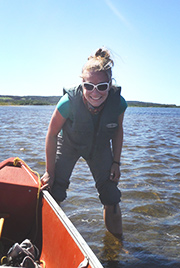Creating homes for waterfowl in the Codroy Valley
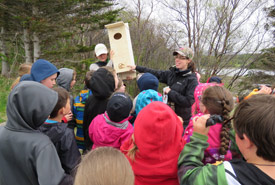
Kathy Unger (NCC) and Danielle Fequet (DUC) showing the students a nest box prior to installation (Photo by NCC)
On May 30, 2016, my colleague Kathy Unger and I had the pleasure of partnering with Ducks Unlimited Canada (DUC) to offer a waterfowl and wetland education event to the students of Belanger Memorial Elementary School.
The Nature Conservancy of Canada (NCC) has engaged with students in Newfoundland’s Codroy Valley since 2014, thanks to the keen interest of the teachers at Belanger Memorial and the continued support of the Codroy Valley Area Development Association. These relationships have allowed NCC to maintain a continued presence in the lives of local students, encouraging pride in and connection with their natural surroundings.
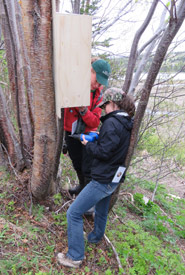
Megan Lafferty (NCC) and Danielle Fequet (DUC) installing one of the nest boxes (Photo by NCC)
This year’s event focused on installing nest boxes! Some waterfowl, such as wood ducks and hooded mergansers, make their nests in tree cavities. These cavities are formed in a number of ways, including woodpecker excavation, disease and lightning strikes. Nest boxes provide additional options for nesting waterfowl. For more information, check out this Nest Box Guide for Waterfowl.
NCC staff introduced the students to nest boxes and the species that use them, before setting out to install the boxes around the estuary. These particular boxes were constructed at previous events hosted by DUC, but anyone can build one by following these instructions.
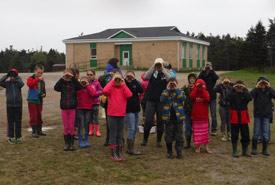
Students using binoculars to survey the estuary for birds (Photo by DUC)
Students learned about how the cleanout door is used to check the box and looked at the inner “ladder,” which the newly hatched ducks climb when leaving the box for their first flight. The group identified sites by looking for areas near the wetlands where the boxes could face the open water. On the walk we also looked for birds, including prospective tenants of our newly hung boxes.
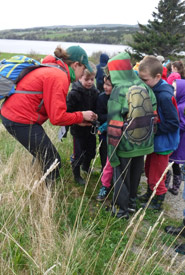
Megan Lafferty (NCC) showing students how the GPS marks where a nest box was installed (Photo by DUC)
Following the event, we provided the teachers with maps to the three nest boxes. Come the end of nesting season, students will be able to visit these locations to see if the boxes were used, make sure they are in good condition and restock the wood shavings within. As the boxes were provided by DUC, they are also registered. This means that any data collected by the students can be submitted to DUC for tracking nest box success and use.
Working with DUC for this event was a natural fit. Not only do NCC and DUC share a common interest in waterfowl and wetland conservation, but we are partners under the Eastern Habitat Joint Venture (EHJV) here in Newfoundland and Labrador. The EHJV program was established under the North American Waterfowl Management Plan, an international partnership to conserve abundant and resilient waterfowl populations and sustainable landscapes.
So while the students of Belanger Memorial were out hanging nest boxes and learning about waterfowl, they were actually, in their own small way, contributing to a continent-wide collaborative conservation initiative (not to mention earning an end-of-trip Freezie; not bad for a day’s work!).

